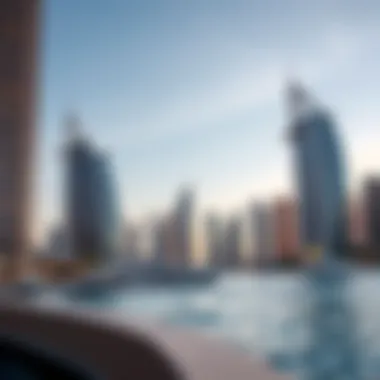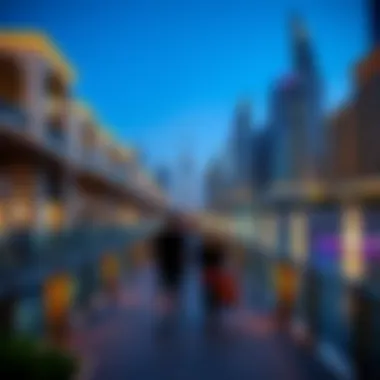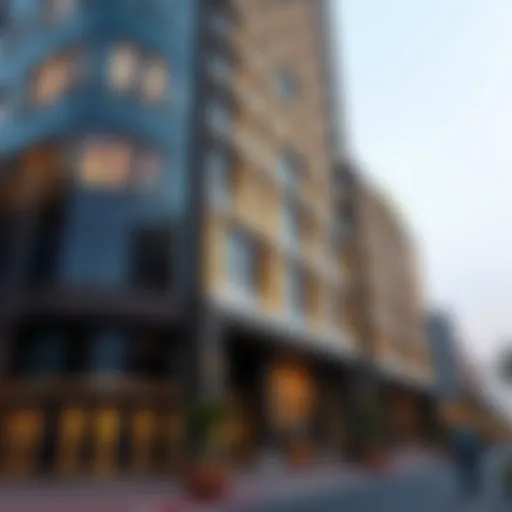Comparing Bosphorus and Dubai Marina Waterfronts


Intro
Bosphorus and Dubai Marina emerge as two pinnacles of waterfront development, each steeped in rich stories and distinctive characteristics. Situated in Istanbul, the Bosphorus has been a crucial conduit for trade and culture for centuries. Meanwhile, Dubai Marina stands as a modern marvel, reflecting the city’s rapid ascent on the global stage. However, beyond the immediate allure of their scenic coastlines, these areas embody the very essence of their cities, shaping local lifestyles and drawing in investors from around the world.
In this article, we will examine their development journeys, architectural styles, and how these regions represent the cultural fabric of their respective locales. For prospective buyers and real estate enthusiasts, understanding the nuances between these two areas provides valuable insights into the dynamic waterfront developments that continue to shape contemporary urban living.
Market Insights
Current Trends in Dubai Real Estate
Dubai’s real estate market is in a period of vibrant growth, marked by innovations and relocations. The Marina, with its stunning skyline and luxury amenities, remains a sought-after destination. According to recent reports, property prices in Dubai Marina have shown resilience despite global economic challenges.
What attracts buyers? First and foremost, the area's proximity to major business districts and high-end retail outlets. Furthermore, the lifestyle focused on leisure and convenience creates an attractive proposition for expatriates and investors alike. Recent projects, such as Bluewaters Island, which hosts the world's largest observation wheel, have added to this area's charm, reinforcing its status as a hotbed for high-return investments.
Key Figures
- 8% increase in property prices over the last year.
- 75% of buyers are expatriates, driven by an appealing lifestyle.
- Increased inquiries for rental properties due to tourism growth.
Predictive Analysis of Future Developments
Looking ahead, the forecast for the Dubai Marina real estate market appears robust. Analysts suggest several trends that may shape the future:
- Rise in demand for eco-friendly developments as sustainability becomes a focal point in urban planning.
- Continued investment in infrastructure to support tourism and residential growth.
- Increased interest from tech companies leading to more mixed-use developments, blurring the lines between residential, commercial, and recreational spaces.
In contrast, the Bosphorus presents a unique market outlook influenced by its historic significance and cultural allure. The waterfront area does not just serve as homes but preserves the rich narratives encapsulating Istanbul’s past and present.
"The Bosphorus isn't merely a location; it’s a living museum reflecting centuries of history while marrying tradition with modernity."
Comparative Analysis
While Dubai Marina focuses on contemporary luxuries, the Bosphorus leans heavily on its historical value. This fundamental difference presents varying investment opportunities in each location, driven by distinct buyer personas. Investors leaning towards modernity might gravitate to Dubai Marina, perhaps choosing luxury high-rises with sprawling views, while those interested in culture may find heritage-rich properties along the Bosphorus more appealing.
Investment Opportunities
High-ROI Neighborhoods
When delving into investment potentials, understanding which neighborhoods to focus on is paramount. In Dubai, areas such as Dubai Marina, Downtown Dubai, and Jumeirah Beach Residence rank high for returns on investment due to their established desirability and robust rental demand. On the Bosphorus, neighborhoods like Ortaköy and Bebek stand out due to their proximity to social hubs, gorgeous views, and rich histories.
Why These Neighborhoods?
- Dubai Marina: High tourist traffic, upscale restaurants, and proximity to job centers.
- Bosphorus: Cultural hubs known for their charm and historical significance, ideal for luxury seekers.
Tips for First-Time Investors
Investing for the first time can feel like navigating uncharted waters. Here are a few pointers:
- Research Thoroughly: Understand the local market trends and property values in both areas.
- Consult Experts: Engage with local real estate professionals who can provide insights tailored to your investment strategy.
- Evaluate Your Priorities: Figure out whether you seek immediate ROI through rental income or long-term value growth and choose your investment location wisely.
In summary, both Bosphorus and Dubai Marina are treasures ripe for exploring in the context of real estate investment, each showcasing a wealth of opportunities and challenges. The decision lies in aligning one's investment strategy with the culture and lifestyle of each waterfront domain.
Overview of Bosphorus
The Bosphorus Strait, a majestic waterway in Turkey, serves as a natural boundary between Europe and Asia. This geographical significance makes it not only a critical transit route for shipping but also a cultural bridge that binds diverse civilizations. In the context of this article, exploring the Bosphorus offers insights into its layered historical narrative, impactful urban development, and the ever-evolving real estate market that continues to attract both local and international investors. This multifaceted area reflects the rich tapestry of Istanbul’s character and continues to be a focal point for cultural and economic activity.
Geographical Significance
Nestled between the Black Sea and the Sea of Marmara, the Bosphorus Strait stretches approximately 31 kilometers. Its strategic location allows for the passage of roughly 50,000 vessels each year — a statistic that is nothing short of remarkable. The twisting path of the strait is surrounded by lush hills, historic palaces, and vibrant neighborhoods, creating an irresistible allure for both residents and tourists. This unique geography not only supports rich biodiversity but also offers stunning views that enhance the desirability of properties along its banks.
Additionally, the Bosphorus is renowned for its role in global commerce. Shipping routes through the Bosphorus are vital for energy supplies and trade between Europe and the east. This geographical advantage has prompted urban development that caters to both leisure and business, spotlighting the area as a key player in the evolving dynamics of the global economy.
Historical Context and Development
The history of the Bosphorus is as intricate as its waters. From ancient times, this strait has witnessed the rise and fall of empires. The Greeks founded Byzantium here, which later became Constantinople during the Roman era. Each civilization left an indelible mark on the architectural landscape. As the Ottoman Empire flourished, palatial constructions and waterfront mansions, known as Yalis, sprang up, echoing the architectural grandeur of the time.
In the modern context, the Bosphorus has undergone significant transformations. The focus on urbanization has been both an asset and a challenge. Infrastructure improvements, including bridges and tunnels, have further integrated this area into Istanbul's urban framework while raising property values immensely. However, developers and planners also grapple with preserving the natural beauty and historical essence of the Bosphorus amid rapid growth and commercialization.
"The Bosphorus is more than just a waterway; it’s a reflection of Istanbul’s soul, where every wave tells a story of past and present."
In summary, the Bosphorus is a critical asset for Istanbul that transcends being a mere geographical feature. It serves as a historical canvas, an economic lifeline, and a thriving hub for investment and development, making it an essential topic of discussion in this comparative study.
Overview of Dubai Marina
Dubai Marina represents a unique blend of cutting-edge architecture and a culturally rich environment that stands out in the urban landscape of Dubai. This section highlights the essential components that shape Dubai Marina's identity, weaving in considerations about its geographical context and historical evolution.
Geographical Significance
Dubai Marina is strategically situated along the Persian Gulf coast and is one of the largest man-made marinas in the world. The location is not just about aesthetics; it plays a crucial role in the accessibility and livability of the area.
- Proximity to Major Landmarks: Adjacent to popular attractions like the Palm Jumeirah and Jumeirah Beach, it provides residents and visitors with ample opportunities for entertainment and leisure. The neighborhood buzzes with life, offering everything from high-end nightclubs to intimate cafes along the waterway.
- Transportation Links: The area boasts excellent transportation options, including the Dubai Metro and water taxis that ferry people around the marina. This connectivity helps to create a vibrant community that thrives on tourism and residential engagement.
- Waterfront Views: The marina's design incorporates stunning views of the Gulf and the skyline of Dubai. With a network of walkways and plazas, it invites strolling, dining, and general enjoyment of the outdoors, making it a hotspot for both locals and tourists.


Historical Context and Development
Originally conceived in the late 1990s, Dubai Marina was developed as an ambitious project to create a unique waterfront experience that would redefine luxury living in the Emirate. Its construction took place in phases, showcasing a deliberate approach to urban development.
- Development Timeline: The early stages saw significant investment driven by the UAE’s vision to become a global hub. As local and international investors delved into opportunities, the area quickly gained traction.
- Architectural Evolution: Over the years, the design ethos has evolved, incorporating modern architectural styles influenced by international trends. Not only has this created diverse skyline but also fostered a sense of identity that is distinctly associated with Dubai's rapid modernization.
- Community Focused Growth: Recent developments have shifted to include more community-oriented spaces, such as parks, family-friendly facilities, and artsy locales. This shift speaks to Dubai's aim of enhancing quality of life while remaining a significant player in the global economy.
"Dubai Marina is not just a location; it embodies the spirit of modern Dubai, fusing luxurious living with vibrant recreational spaces."
In summary, the significance of Dubai Marina extends beyond mere geography. The developments and history reflect a well-thought-out integration of lifestyle, leisure, and luxury, ideally appealing to investors, homeowners, and expatriates alike.
Architectural Styles in Bosphorus
The architectural styles present along the Bosphorus are a tapestry woven from the varied historical, cultural, and artistic influences that have shaped the region over centuries. This section dives into how these styles not only define the aesthetic of the landscape but also reflect the social and cultural evolution of this iconic waterway. Understanding these architectural styles is essential for potential investors, homeowners, and anyone intrigued by the unique character of the Bosphorus, as they offer insights into the value and atmosphere of properties in this prime location.
Influence of Ottoman Architecture
Ottoman architecture is perhaps the most notable influence on the buildings that line the Bosphorus. Many of the palaces, mosques, and residences designed during the Ottoman era create a coherent historical narrative that speaks of power, artistry, and tradition. The Topkapi Palace, for instance, stands as a testament to the grandeur of the Ottoman Empire, showcasing intricate tile work and sprawling gardens that merge seamlessly with the surrounding waterways.
- Key Elements: The use of domes, arches, and ornate decorations are hallmark characteristics that can be seen in various structures around the Bosphorus. This architectural language creates a sense of unity along the waterfront, where each building complements its neighbor.
- Cultural Reflections: These structures are not simply about beauty; they represent a way of life and the historical context of a period when Istanbul was at the center of the world. The blend of Islamic and Byzantine influences highlights a fusion that is unique to this region.
The preservation of these architectural styles is vital, as they reinforce the identity of the Bosphorus as a cultural and historical landmark. For investors, properties in these historical areas can become significant assets, blending luxury living with a slice of history.
Contemporary Developments
As one strolls along the waterfront today, it becomes evident that modern architectural developments coexist with the traditional structures. Contemporary designs in Bosphorus aim to harmonize with their historic surroundings while also addressing today's lifestyle preferences.
- Innovation and Aesthetics: Modern buildings are often characterized by sleek lines, glass facades, and eco-friendly materials. Such designs can be seen in luxury apartments and commercial spaces that prioritize sustainability, catering to a growing demand for environmentally-conscious living.
- Community-Focused Spaces: Newer developments frequently incorporate communal areas, waterfront parks, and recreational facilities to enhance the quality of life for residents. This focus on lifestyle amenity spaces is increasingly appealing to both buyers and renters.
Interestingly, the interplay between contemporary styles and historical architecture often reflects in how developers approach luxury living along the Bosphorus. Fine dining options, boutique shops, and cultural venues are integrated into these spaces to create thriving communities that maintain the charm of the area.
"The architecture along the Bosphorus is not just a matter of aesthetics; it's a dialogue between history and modernity that continues to evolve."
Architectural Styles in Dubai Marina
The architectural landscape of Dubai Marina is truly a spectacle that reflects the city's ambition and contemporary ethos. With its remarkable skyline, diverse designs, and innovative concepts, this area not only serves as a visual feast but also plays a crucial role in defining the experience of urban living. Analyzing the architectural styles in Dubai Marina gives us insight into how modern advancements meld with the desires of residents and investors alike. The conversation around this topic encompasses the aesthetic appeal and the functional benefits these designs bring to the table.
Modern Skyscrapers and Designs
Modern skyscrapers characterize Dubai Marina, boasting a mix of glass facades and inventive shapes that twist and turn against the skyline. These structures are more than just high-rises; they symbolize Dubai's commitment to pushing boundaries and striving for excellence in design. Towers such as the Cayan Tower, infamously known as the "Twisting Tower", captivate with their unique spiral shape, while the majestic Marina Heights showcases stunning panoramic views of the sea and the city.
The use of cutting-edge technology in construction significantly enhances the durability and sustainability of these buildings. For instance, advancements in insulating glass minimize heat gain, contributing to energy efficiency and comfort for residents. Another noteworthy architectural gem is the royal blue and gold-hued designed skyscrapers that not only serve aesthetic purposes but are also engineered to endure coastal winds and other natural elements.
Key Features of Modern Skyscrapers:
- Innovative Designs: Towers like the Princess Tower, one of the tallest residential buildings globally, emphasize sleek lines and modern aesthetics.
- Sky Gardens and Balconies: Many towers incorporate green spaces, promoting a healthier lifestyle while providing breathtaking views.
- Smart Building Technology: Features like automated lighting and climate control offer comfort and reduce energy consumption.
Sustainability Practices
In the quest for sustainability, Dubai Marina is making strides that rival any major urban center. Architects and developers are consciously integrating environmentally friendly methods into their designs, reflecting a growing awareness of the ecological footprint of urban living. The concept of green building has gained traction in the area, with numerous developments aiming for LEED certifications.
Innovative features such as solar panels, energy-efficient lighting, and water conservation systems are not just buzzwords but are becoming standard practices in many new developments. Additionally, the inclusion of landscaped rooftops and vertical gardens not only enhances visual appeal but also assists in improving air quality and biodiversity in the area.
Importantly, the local authorities actively encourage such practices through regulatory frameworks that incentivize sustainability. The incorporation of public transport solutions, including water taxis and pedestrian pathways, further emphasizes a commitment to reducing carbon emissions, leading to a more holistic approach to urban living.
"The Marina demonstrates how architectural innovation can harmoniously blend modern lifestyle aspirations with sustainability principles."
Benefits of Sustainability Practices:
- Reduced Operating Costs: Energy-efficient designs lead to lower energy bills for residents and businesses.
- Enhanced Marketability: Properties that prioritize sustainability often attract buyers looking for ethical investment options.
- Improvement in Quality of Life: Greater access to greenery and clean air contributes to the well-being of residents.
This in-depth understanding of the architectural styles in Dubai Marina elucidates how they are not only landmarks of luxury but also reflections of a progressive, environmentally aware society aiming for a vibrant future.
Real Estate Market Dynamics in Bosphorus
The Bosphorus region stands out as a critical real estate market in Istanbul, thanks to a blend of both cultural richness and strategic geographical positioning. This part of the city is not just about beautiful landscapes and historical significance; it is a vibrant market catering to people looking for homes, investment properties, and luxurious retreats.
Real estate dynamics here reflect the pulse of Istanbul's economy and its evolving identity as a metropolis. These market trends show unique characteristics that appeal to both local and international investors.
Property Types and Trends
In Bosphorus, property types are diverse, ranging from charming historical mansions to sleek and modern apartments. Findings show that:
- Historical Yali (waterfront mansions) are highly coveted, offering not just living space but a glimpse into Ottoman grandeur that seems to whisper stories of a past age.
- New high-rise developments cater to the younger demographic, featuring amenities like swimming pools, gyms, and sky gardens. This shift signals a balance between maintaining Istanbul's heritage while accommodating modern lifestyle needs.
On top of that, property prices have been through a wild ride lately. Experts note that in the last few years, values surged, driven by both local demand and foreign investments. Prices near the waterfront are often significantly higher due to the view of the strait. Investors keen on property in Bosphorus often find themselves competing fiercely, as each property presents a unique opportunity.
Investment Opportunities
For investors eyeing the Bosphorus, opportunities abound. Many see this area not just as a place to live, but as a smart investment choice.


Some enticing factors include:
- Cultural Capital: Investing in properties close to landmarks such as the Çamlıca Mosque or the Dolmabahçe Palace can lead to lucrative rental yields, especially during peak tourism seasons.
- Urban Revitalization: Initiatives are underway to modernize waterfront districts. This means that investing now could result in substantial profit as neighborhoods undergo transformation.
- Luxury Living: A notable trend is how the luxury market is thriving with the demand for high-end properties rising in tandem with lifestyle changes post-pandemic. This trend presents a twofold opportunity for both high-net-worth individuals and developers aiming to cater to this demographic.
Investing in the Bosphorus real estate market is about grasping the intersection of history, culture, and modern living. With a keen eye, investors can uncover hidden gems that promise to appreciate over time.
In summary, the real estate dynamics in Bosphorus present a balanced mix of risk and reward, beckoning investors, both seasoned and new, to take a closer look at what this storied region has to offer.
Real Estate Market Dynamics in Dubai Marina
The dynamic real estate market in Dubai Marina is a riveting tapestry woven from multiple threads that influences and aligns with the broader trends in urban development and economic growth. This area not only showcases residential properties but also serves as a fashionable hub teeming with commercial enterprises and lifestyle amenities. It has attracted both local and international investors, making it a beacon for growth in the property sector. Understanding the specific elements of this market is crucial for discerning potential buyers and investors who wish to navigate this vibrant waterfront development.
Property Types and Trends
In Dubai Marina, the property landscape is as varied as it is striking. Here, prospective homeowners and investors can find an eclectic mix of offerings including waterfront villas, high-rise apartments, and luxury penthouses. Notably, the towering structures, like the Princess Tower and the Elite Residence, have become symbols of opulence and modern living. Many of these buildings couple luxury with functionality, often featuring amenities like swimming pools, gyms, and dedicated parking spaces.
Alongside residential offerings, commercial properties, retail outlets, and dining establishments contribute significantly to the overall market. The trend of mixed-use developments is gaining momentum, which means living spaces are often integrated with leisure and shopping experiences.
Potential buyers should take note of these evolving trends:
- High Demand for Luxury Rentals: As expatriates flock to Dubai, the demand for high-end rental properties in the Marina remains robust.
- Shifts Towards Sustainability: New constructions tend to lean towards eco-friendly designs and energy-efficient technologies. Properties with green certifications often command higher prices and attract a premium.
- Prominent Developer Influence: Established developers like Emaar and DMCC underpin a lot of the market activity, ensuring high standards and quality control in newly constructed properties.
To keep pace with these developments, investors should be well-versed in the current market dynamics, including shifts in tenant preferences and evolving architectural designs in the marina.
Investment Opportunities
The investment prospects in Dubai Marina are not just promising; they are reflective of the region's ambition and growth trajectory. Investors have a wealth of options at their fingertips, driven by a blend of renting and purchasing opportunities. A few points of interest include:
- Tourism-Driven Demand: Dubai Marina attracts millions of visitors each year, ensuring a steady rental market, which appeals to investors looking for passive income.
- Government Initiatives: The UAE government has introduced various schemes aimed at making property acquisition smoother for overseas investors. Long-term visas and ownership rights have made the neighborhood even more attractive.
- Resilience to Market Fluctuations: The Marina tends to show resilience against global economic downturns, performing comparatively better than other regions during economic slumps.
"In real estate, location is prime, but understanding market dynamics solidifies investment success."
Consideration of upcoming projects in the pipeline can provide insight into where the market is headed. Keeping a pulse on the latest developments in infrastructure, community building precepts, and shifts in buyer demographics will empower savvy investors to stay ahead of the curve in capitalizing on this buzzing area.
Cultural Significance of Bosphorus
The Bosphorus is not just a waterway; it is the lifeblood of Istanbul, threading together cultures, histories, and peoples. To understand the cultural significance of the Bosphorus, one must delve into what makes this strait pivotal not just geographically, but also within the spiritual and emotional fabric of Turkey. Its banks are lined with mansions, palaces, and traces of the diverse influences that have shaped Turkish identity over the centuries.
Role in Turkish Identity
The Bosphorus serves as a symbol of Turkish identity by embodying the confluence of East and West. Throughout history, it has been both a barrier and a bridge. This duality is critical in understanding Turkish culture. Many locals refer to it as the
Cultural Significance of Dubai Marina
Dubai Marina is not just a livable space adorned with luxurious towers and vibrant nightlife; it resonates deeply within the Emirati identity. The area is a testimony to the rapid urban transformation Dubai has undergone, marrying tradition with modernity. As a result, it plays a pivotal role in shaping not only the skyline but also the cultural narrative of the emirate.
Role in Emirati Identity
The development of Dubai Marina marks a significant chapter in the story of the UAE’s growth. This waterfront community encapsulates the aspirational nature of Emirati society, symbolizing progress and determination. It is a place where innovations in architecture and urban planning reflect the broader ambitions of the nation. Residents often take pride in being part of a community that represents a harmonious blend of luxury living and cultural diversity.
Moreover, this area draws both expatriates and locals alike, fostering an environment of cultural exchange. Events and festivals held in the Marina, such as the Dubai International Boat Show and various cultural fairs, allow citizens to celebrate not just local Emirati culture but also the rich traditions of those who have chosen to call Dubai home.
This vibrant microcosm of life illustrates how modern aspirations coexist with traditional values, reinforcing national identity while promoting inclusivity.
Tourism and Entertainment Venues
Dubai Marina is a hotspot for tourism, offering a variety of entertainment venues that attract millions each year. The promenade, teeming with shops, cafes, and restaurants, creates a lively atmosphere. Tourists flock to the area to experience something variously thrilling and relaxing, sitting on the edge of the water, gazing at the breathtaking skyline, or indulging in culinary delights.
- Key Attractions:
- Marina Walk: Enclosed by glistening waters, this waterfront development is perfect for leisurely strolls and casual dining, embodying the spirit of community interaction.
- JBR Beach: Just a stone's throw away, this public beach area boasts water sports, sunbathing, and a festive atmosphere ideal for families.
- Ain Dubai: As the world’s tallest observation wheel, it adds a touch of grandeur to the coastline and serves as an icon for the emirate.
The prominence of Dubai Marina's nightlife is a critical draw for visitors. With rooftop lounges and vibrant nightclubs, it caters to various tastes, from chill rooftop bars to high-energy dance clubs. The carefully curated mix of offerings presents a dynamic entertainment landscape that enhances the appeal of Dubai as an emerging global city.
Future Outlook for Bosphorus
The Bosphorus Strait, often viewed as the lifeblood of Istanbul, carries with it both hope and anticipation for the future. As we look ahead, it’s crucial to consider how this pivotal waterway continues to evolve. The importance of understanding the future outlook for Bosphorus lies in its potential to shape not only the real estate market but also the cultural and environmental narrative of the region. The Bosphorus has long been a bridge connecting continents, and as Turkey positions itself on the global stage, its waterfront development plays a significant role in attracting investment and enhancing living standards.
Challenges and Opportunities
Neglecting the realities facing Bosphorus can lead to missed opportunities. One of the major challenges is the environmental degradation resulting from unchecked development and pollution. High levels of urbanization have led to the overexploitation of resources, affecting marine life and the overall ecosystem. However, with the right policies and community engagement, these challenges also present a chance to innovate and improve sustainability practices.
Investors must navigate the regulatory landscape, which can sometimes be fraught with bureaucratic delays. Yet, this complexity also means the barriers to entry can act as a safeguard against oversaturation, preserving market value for existing properties. Climate change poses another hurdle, particularly concerning rising sea levels and the impact of extreme weather events. Yet, this foregrounds the necessity for adaptive architecture—structures that can withstand the test of time and nature.
Some opportunities are as clear as day. The demand for luxury residences remains robust, as the waterfront experience appeals to local and foreign buyers alike. Developing mixed-use spaces that combine residential, commercial, and recreational areas can cater to contemporary lifestyle trends. Additionally, the government's emphasis on infrastructure improvement means better connectivity, which further enhances the attractiveness of the region.
"Istanbul’s skyline is not just iconic; it’s a reflection of the city’s dynamic spirit and ongoing evolution."
Long-term Development Plans


As the future unfolds, the Bosphorus is set to experience transformative changes. Long-term development plans promise to reshape not just the waterfront but also the entire urban landscape. The focus is on creating a sustainable ecosystem that respects local heritage while accommodating modern needs.
Key projects are already in the pipeline, including initiatives to regenerate historically significant neighborhoods along the shores. These plans aim to blend contemporary design with Ottoman-style architecture, appealing to both history buffs and modern enthusiasts. Moreover, improving public transport and pedestrian access will make navigating this beautiful area far more user-friendly.
Utilizing technology will also play a vital role. Smart city solutions are on the table, with integrated systems that manage energy consumption, waste management, and traffic flow efficiently. These advancements not only make life easier for residents but also enhance the overall attractiveness of Bosphorus as a place to live, work, and play.
In addition, community engagement in these plans ensures that the voice of the local population is taken into account, leading to more inclusive development. Businesses that cater to both residents and tourists are expected to thrive, creating a vibrant economic environment.
Future Outlook for Dubai Marina
The future of Dubai Marina is a crucial topic as it encapsulates the evolving landscape of urban development, catering to both investors and residents alike. Understanding this outlook involves a meticulous examination of ongoing trends and potential growth areas. The Marina's strategic position along the waterfront underpins its ongoing appeal, while the planned developments promise to reshape its character and economic viability over time.
Challenges and Opportunities
Dubai Marina, despite its glitzy veneer, faces several challenges that potential investors and stakeholders must consider. Among these challenges include:
- Market Saturation: With numerous luxury apartments and commercial spaces, there is a risk of oversupply that could depress rental yields and property prices.
- Economic Fluctuations: Global economic instability can affect tourist inflows and foreign investment, impacting the real estate market.
- Environmental Considerations: Development projects must adhere to sustainability practices. Addressing climate change and environmental degradation is an ongoing challenge for the region.
However, these challenges present unique opportunities as well:
- Regulatory Reforms: The local government is continuously working on enhancing the ease of doing business, which can attract more investors.
- High Demand in Niche Markets: There is still a strong demand for short-term rental properties, catering to tourists and expatriates who prefer luxury and convenience.
- Investment in Infrastructure: Planned infrastructure developments, like new metro lines and improved connectivity, can boost property value and desirability.
"Investing in Dubai Marina is like riding a rollercoaster. There are ups and downs, but with the right insights, it can lead to great excitement and opportunities."
Long-term Development Plans
Dubai Marina is witnessing a flurry of development initiatives designed to reinforce its standing as a premier waterfront destination. These long-term plans entail:
- Mixed-use Developments: There are plans for mixed-use complexes that combine residential, commercial, and retail spaces under one roof, aiming to create vibrant community hubs.
- Green Spaces: The burgeoning emphasis on sustainability includes the addition of parks and recreational areas, enhancing the overall living experience and appealing to families.
- Smart Technologies: Implementing smart city technologies for efficient energy use, transportation solutions, and improved security is steadily being integrated into future projects.
Each of these initiatives reflects the region's commitment to maintaining the allure of Dubai Marina as a thriving residential and commercial environment while ensuring long-term sustainability and profitability.
In summary, the outlook for Dubai Marina is intertwined with both its current challenges and fruitful opportunities. The long-term strategies indicate a focus on growth, community, and maintaining a competitive edge within a global context. Investors, homeowners, and analysts would do well to keep a close watch on developments in this characteristic waterfront haven.
Comparative Analysis
When navigating the realms of waterfront developments, the comparative analysis of Bosphorus and Dubai Marina serves as a vital lens through which we can explore the unique attributes and challenges that each location presents. This examination does not merely highlight similarities and differences; it unveils the underlying factors that contribute to the allure of these iconic sites, hence proving beneficial for investors, homeowners, and urban planners alike. Understanding the comparative elements deeply enriches our appreciation for how two diverse environments can shape the urban experience in distinct ways.
Strengths and Weaknesses
Every urban development possesses its own set of strengths and weaknesses, and this holds true for both the Bosphorus and Dubai Marina.
Strengths of Bosphorus:
- Cultural Heritage: The Bosphorus is steeped in history, acting as a bridge between two continents with its rich cultural tapestry. The architectural beauty is a mix of ancient and modern styles that attract many tourists.
- Geographic Appeal: It offers stunning views and a unique geographical setting that draws both locals and expatriates.
Weaknesses of Bosphorus:
- Regulatory Constraints: Stringent regulations can limit new developments. Property laws can be complex, making the investment landscape a bit murky for first-time buyers.
- Infrastructure Challenges: Aging infrastructure and urban congestion can diminish the living experience for residents.
Strengths of Dubai Marina:
- Modern Amenities: Dubai Marina boasts state-of-the-art facilities, sophisticated skyscrapers, and expansive leisure options. This contemporary appeal is attractive for a younger demographic.
- Strong Real Estate Market: A robust property market with constant demand allows for various investment opportunities.
Weaknesses of Dubai Marina:
- High Living Costs: The cost of living and property prices can be exorbitant compared to other areas in Dubai.
- Tourism Saturation: While tourism is good for business, it can lead to overcrowding, affecting the quality of life for residents.
This strengths and weaknesses analysis offers valuable insight for potential stakeholders to consider before making any property decisions in either location.
Key Differentiators
By distilling the essence of both waterfronts, several key differentiators emerge, delineating the unique selling points that can resonate with different target audiences.
- Cultural Context:
The Bosphorus represents a fusion of eastern and western cultures, steeped in centuries-old traditions. In contrast, Dubai Marina aligns itself with modernity and forward-thinking aspirations, yet still retains elements of Emirati culture. - Architectural Identity:
The architectural styles along the Bosphorus reflect a deep-rooted historical legacy. Over in Dubai Marina, the skyline is dominated by futuristic skyscrapers, symbolizing global elegance and innovation. - Investment Viability:
The Bosphorus can present challenges for investors due to regulatory hurdles but offers timeless value. Dubai Marina, on the other hand, sits in a rapidly evolving market that often promises high yields, making it attractive for fast-paced investors. - Lifestyle Offerings:
The lifestyle on the Bosphorus is a blend of serene coastal living with vibrant cultural interactions, perfect for those who appreciate a slower pace. Conversely, the Dubai Marina lifestyle revolves around luxury, nightlife, and active recreation, ideal for a more energetic crowd.
Through this comparative lens, the reader can grasp the broader implications related to investment considerations, lifestyle choices, and cultural appreciation.
As we delve deeper into this analysis, potential buyers and investors can thoughtfully evaluate which waterfront aligns with their vision and aspirations.
Ending
The exploration of the Bosphorus and Dubai Marina unveils much more than just their alluring waterfronts. These two developments serve as microcosms of their respective cities, reflecting unique cultural identities and economic aspirations. For investors, understanding these nuanced characteristics is key to making informed decisions.
Implications for Investors
Investing in either the Bosphorus or Dubai Marina involves careful consideration of several factors. Here are some important points to keep in mind:
- Market Variability: Real estate markets in these regions can fluctuate due to local and global economic conditions. The Bosphorus, with its historical significance and limited land availability, presents unique challenges and opportunities. Conversely, the ever-evolving skyline of Dubai Marina embodies growth and innovation, often attracting a global clientele.
- Property Types: In Bosphorus, potential buyers can find a mix of traditional Turkish mansions and contemporary apartments, which adds a little spice to investment diversification. Dubai Marina, on the other hand, offers modern high-rises with cutting-edge amenities, appealing to young professionals and affluent expatriates.
- Cultural Considerations: Understanding local customs and preferences is vital when entering these markets. Bosphorus properties often feature architectural styles that reflect Turkish heritage, which may contribute to their long-term value. Dubai Marina’s modernity, influenced by international design trends, attracts a different type of buyer – one that values luxury and contemporary aesthetics.
- Long-term Outlook: Looking toward the future, investors should weigh the long-term development plans of each area. The Bosphorus is undergoing revitalization projects, enhancing accessibility and amenities, which could increase property values. Meanwhile, Dubai Marina is set to continue its expansion, driven by ongoing investments and developments in infrastructure and lifestyle facilities.
Final Thoughts
The comparative study of the Bosphorus and Dubai Marina reveals the rich tapestry of possibilities for various investors. Both locations bring unique attributes to the table, catering to different preferences and investment philosophies. The Bosphorus, steeped in history and culture, offers potential for stable investments in a limited market. Dubai Marina’s dynamic landscape is a playground for those seeking fast-paced growth in a vibrant economy.
"Investment is not just about numbers; it’s about understanding the essence of a place and how it fits into the larger picture."
For more insights and detailed market analysis, additional resources such as Wikipedia, Britannica, or industry-specific publications can provide invaluable information.







